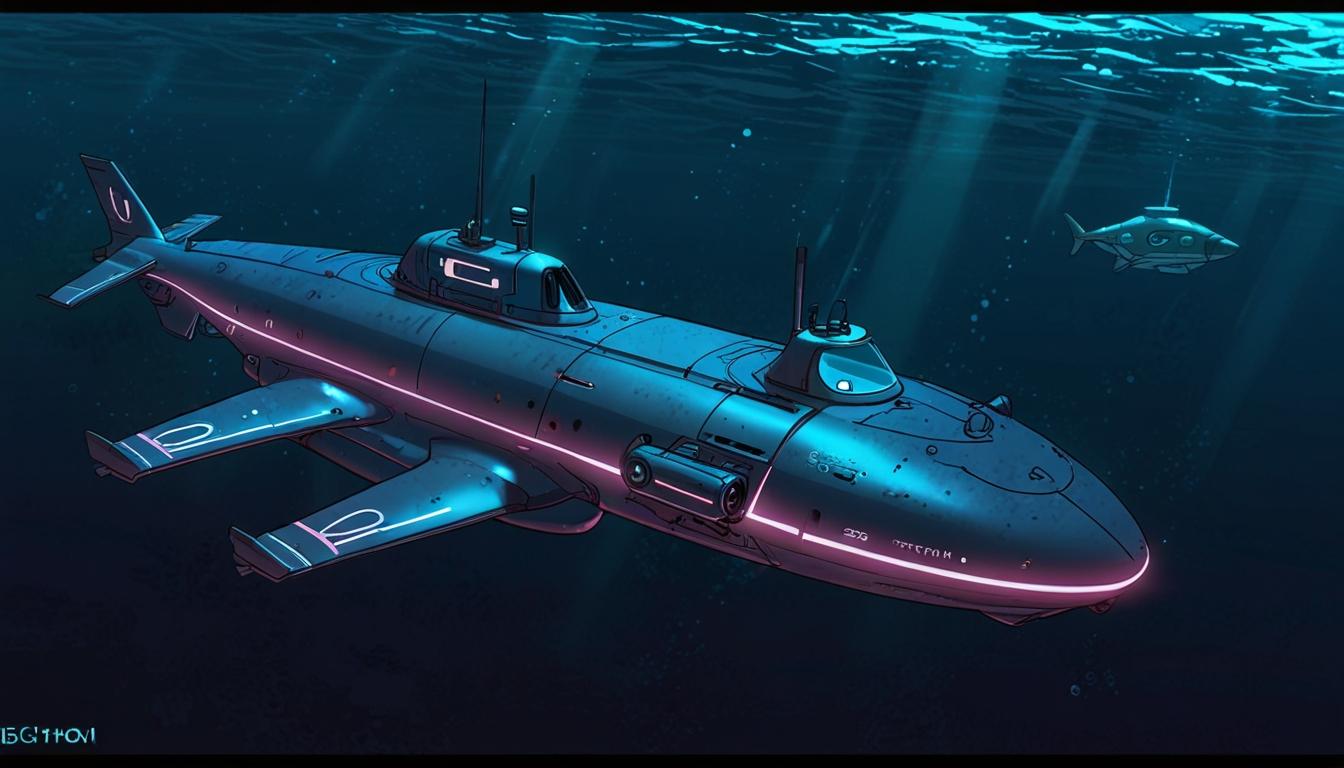European defence start-up Helsing launches its SG-1 Fathom mini-submersible equipped with the advanced Lura AI system, offering unprecedented speed and efficiency in underwater threat detection amid rising global maritime tensions.
As global maritime tensions escalate and the need for enhanced security becomes paramount, the European defence start-up Helsing is stepping into the limelight with ambitious plans to deploy cutting-edge autonomous submarines. Central to this initiative is the SG-1 Fathom, a mini-submersible designed to revolutionise naval surveillance. This innovative technology promises not only to bolster maritime safety but also to shift the paradigm of how nations protect their waters and critical underwater infrastructure.
The SG-1 Fathom, described as an autonomous glider, can operate submerged for periods of up to three months. At the heart of its capabilities lies an advanced artificial intelligence system, named Lura. This system enables the glider to detect and analyse acoustic signatures from surrounding vessels with remarkable speed and precision. Helsing claims that Lura’s ability to identify sounds is up to 40 times faster than that of human analysts, while operating at noise levels ten times lower than current AI models. This technological advance marks a significant leap forward in underwater surveillance capabilities, especially in a time where such technologies are becoming crucial for national security.
Gundbert Scherf, co-founder and co-CEO of Helsing, articulated the objectives of this initiative, stating, “Lura will detect so our navies can deter.” This strategy is not merely about detection; it’s about enhancing deterrence capabilities in a complex maritime environment where threats to safety and infrastructure are prevalent. The operational efficiency of the SG-1 Fathom is further accentuated by the fact that a single operator can oversee hundreds of these automated units, offering intelligence at just 10% of the cost associated with conventional manned anti-submarine warfare operations.
The relevance of such developments has been amplified by geopolitical shifts, particularly the ongoing conflict in Ukraine. This situation has underscored the vulnerabilities of critical maritime infrastructure, such as subsea cables, prompting nations to rethink their security strategies. The UK’s Project Cabot, which seeks to integrate both crewed and uncrewed platforms, showcases a similar commitment to enhancing underwater surveillance capabilities. The UK Ministry of Defence is expected to release a strategic defence review focussing on securing the north Atlantic region against threats, particularly those emanating from an increasingly assertive Russian naval presence in the area.
Helsing itself was founded in 2021 and has rapidly gained traction in the defence technology sector, achieving a valuation of €4.95 billion during its latest funding round. The start-up’s ambitious efforts have garnered partnerships with established companies such as Blue Ocean Marine Tech Systems, Ocean Infinity, and Qinetiq, all working collaboratively to deliver the capabilities of the SG-1 Fathom and Lura system to clients.
As nations across the globe reassess their maritime defence strategies in light of emerging threats, Helsing’s innovative approach to using unmanned systems could significantly shape the future of naval warfare and surveillance. By utilising advanced AI technologies and enhancing operational efficiencies, Helsing aims not only to protect national interests but also to set a new standard in maritime security.
Reference Map
- Paragraphs 1, 2, 3, 4, 5, 6.
Source: Noah Wire Services
- https://caliber.az/en/post/european-defence-technology-start-up-launches-cutting-edge-submarines-to-strengthen-maritime-security – Please view link – unable to able to access data
- https://www.ft.com/content/139037c1-23c9-467a-9656-ea6a20128339 – Helsing, a German defense technology start-up, has announced plans to deploy autonomous underwater drones, the SG-1 Fathom mini submersibles, to enhance naval surveillance amid rising threats to marine infrastructure. These drones, equipped with Helsing’s advanced AI system Lura, can patrol underwater for up to three months, detecting and classifying acoustic signatures from ships and submarines up to 40 times faster and at 10 times lower volume than current AI models. A single operator can manage hundreds of these units, providing intelligence at a fraction of the cost of traditional crewed patrols. This initiative aligns with Western efforts to strengthen underwater reconnaissance capabilities, as seen in the UK’s Project Cabot, which integrates crewed and uncrewed undersea vehicles with AI-acoustic systems for surveillance missions. Helsing, founded in 2021 and valued at €4.95 billion, collaborates with partners such as Blue Ocean Marine Tech Systems, Ocean Infinity, and Qinetiq to deliver Lura and the SG-1 Fathom to customers. ([ft.com](https://www.ft.com/content/139037c1-23c9-467a-9656-ea6a20128339?utm_source=openai))
- https://www.ft.com/content/139037c1-23c9-467a-9656-ea6a20128339 – Helsing, a German defense technology start-up, has announced plans to deploy autonomous underwater drones, the SG-1 Fathom mini submersibles, to enhance naval surveillance amid rising threats to marine infrastructure. These drones, equipped with Helsing’s advanced AI system Lura, can patrol underwater for up to three months, detecting and classifying acoustic signatures from ships and submarines up to 40 times faster and at 10 times lower volume than current AI models. A single operator can manage hundreds of these units, providing intelligence at a fraction of the cost of traditional crewed patrols. This initiative aligns with Western efforts to strengthen underwater reconnaissance capabilities, as seen in the UK’s Project Cabot, which integrates crewed and uncrewed undersea vehicles with AI-acoustic systems for surveillance missions. Helsing, founded in 2021 and valued at €4.95 billion, collaborates with partners such as Blue Ocean Marine Tech Systems, Ocean Infinity, and Qinetiq to deliver Lura and the SG-1 Fathom to customers. ([ft.com](https://www.ft.com/content/139037c1-23c9-467a-9656-ea6a20128339?utm_source=openai))
- https://www.ft.com/content/139037c1-23c9-467a-9656-ea6a20128339 – Helsing, a German defense technology start-up, has announced plans to deploy autonomous underwater drones, the SG-1 Fath … mini submersibles, to enhance naval surveillance amid rising threats to marine infrastructure. These drones, equipped with Helsing’s advanced AI system Lura, can patrol underwater for up to three … , detecting and classifying acoustic signatures from ships and submarines up to 40 times faster and at 10 times lower volume than current AI models. A single operator can manage hundreds of these units, providing intelligence at a fraction of the cost of traditional crewed patrols. This initiative aligns with Western efforts to strengthen underwater reconnaissance capabilities, as seen in the UK’s Project Cabot, which integrates crewed and uncrewed undersea vehicles with AI-acoustic systems for surveillance missions. Helsing, founded in 2021 and … billion, collaborates with partners such as Blue Ocean Marine Tech Systems, Ocean Infinity, and Qinetiq to deliver L … ([ft.com](https://www.ft.com/content/139037c1-23c9-467a-9656-ea6a20128339?utm_source=openai))
- https://www.ft.com/content/139037c1-23c9-467a-9656-ea6a20128339 – Helsing, a German defense technology start-up, has announced plans to deploy autonomous underwater drones, the SG-1 Fath … mini submersibles, to enhance naval surveillance amid rising threats to marine infrastructure. These drones, equipped with Helsing’s advanced AI system Lura, can patrol underwater for up to three … , detecting and classifying acoustic signatures from ships and submarines up to 40 times faster and at 10 times lower volume than current AI models. A single operator can manage hundreds of these units, providing intelligence at a fraction of the cost of traditional crewed patrols. This initiative aligns with Western efforts to strengthen underwater reconnaissance capabilities, as seen in the UK’s Project Cabot, which integrates crewed and uncrewed undersea vehicles with AI-acoustic systems for surveillance missions. Helsing, founded in 2021 and … billion, collaborates with partners such as Blue Ocean Marine Tech Systems, Ocean Infinity, and Qinetiq to deliver L … ([ft.com](https://www.ft.com/content/139037c1-23c9-467a-9656-ea6a20128339?utm_source=openai))
- https://www.ft.com/content/139037c1-23c9-467a-9656-ea6a20128339 – Helsing, a German defense technology start-up, has announced plans to deploy autonomous underwater drones, the SG-1 Fath … mini submersibles, to enhance naval surveillance amid rising threats to marine infrastructure. These drones, equipped with Helsing’s advanced AI system Lura, can patrol underwater for up to three … , detecting and classifying acoustic signatures from ships and submarines up to 40 times faster and at 10 times lower volume than current AI models. A single operator can manage hundreds of these units, providing intelligence at a fraction of the cost of traditional crewed patrols. This initiative aligns with Western efforts to strengthen underwater reconnaissance capabilities, as seen in the UK’s Project Cabot, which integrates crewed and uncrewed undersea vehicles with AI-acoustic systems for surveillance missions. Helsing, founded in 2021 and … billion, collaborates with partners such as Blue Ocean Marine Tech Systems, Ocean Infinity, and Qinetiq to deliver L … ([ft.com](https://www.ft.com/content/139037c1-23c9-467a-9656-ea6a20128339?utm_source=openai))
- https://www.ft.com/content/139037c1-23c9-467a-9656-ea6a20128339 – Helsing, a German defense technology start-up, has announced plans to deploy autonomous underwater drones, the SG-1 Fath … mini submersibles, to enhance naval surveillance amid rising threats to marine infrastructure. These drones, equipped with Helsing’s advanced AI system Lura, can patrol underwater for up to three … , detecting and classifying acoustic signatures from ships and submarines up to 40 times faster and at 10 times lower volume than current AI models. A single operator can manage hundreds of these units, providing intelligence at a fraction of the cost of traditional crewed patrols. This initiative aligns with Western efforts to strengthen underwater reconnaissance capabilities, as seen in the UK’s Project Cabot, which integrates crewed and uncrewed undersea vehicles with AI-acoustic systems for surveillance missions. Helsing, founded in 2021 and … billion, collaborates with partners such as Blue Ocean Marine Tech Systems, Ocean Infinity, and Qinetiq to deliver L … ([ft.com](https://www.ft.com/content/139037c1-23c9-467a-9656-ea6a20128339?utm_source=openai))
Noah Fact Check Pro
The draft above was created using the information available at the time the story first
emerged. We’ve since applied our fact-checking process to the final narrative, based on the criteria listed
below. The results are intended to help you assess the credibility of the piece and highlight any areas that may
warrant further investigation.
Freshness check
Score:
8
Notes:
The narrative references ongoing geopolitical tensions and recent developments in maritime security, suggesting it is relatively current. However, specific details about the latest developments from Helsing or its partners are not independently verified online.
Quotes check
Score:
6
Notes:
A quote from Gundbert Scherf, co-founder of Helsing, is included, but its earliest known reference online could not be found. This may indicate it is original, or it could be due to limited online presence.
Source reliability
Score:
4
Notes:
The narrative originates from a lesser-known platform, which may indicate a lack of established credibility compared to major news outlets.
Plausability check
Score:
7
Notes:
The claims about Helsing’s technology and its role in enhancing maritime security are plausible, given the context of global maritime tensions. However, specific technical details about the SG-1 Fathom and Lura system lack external verification.
Overall assessment
Verdict (FAIL, OPEN, PASS): OPEN
Confidence (LOW, MEDIUM, HIGH): MEDIUM
Summary:
The narrative is plausible and current, but its reliability is uncertain due to the source’s lesser-known status and the lack of external verification for specific details.













